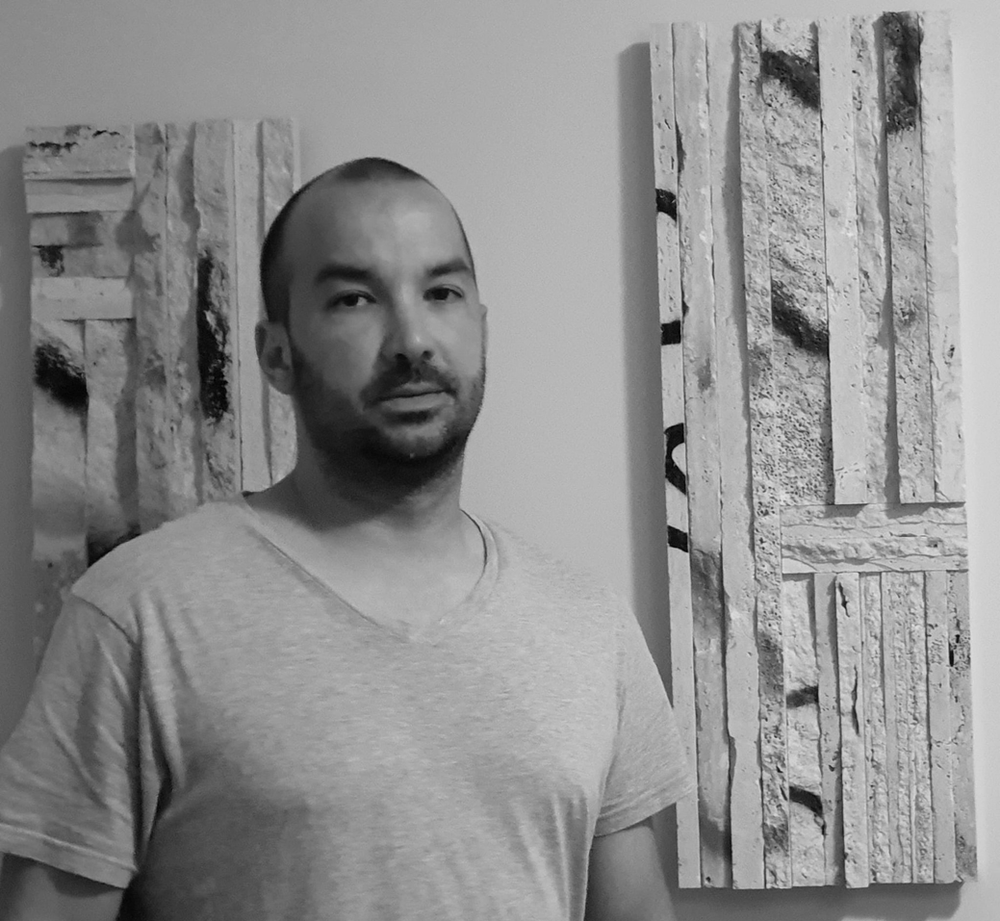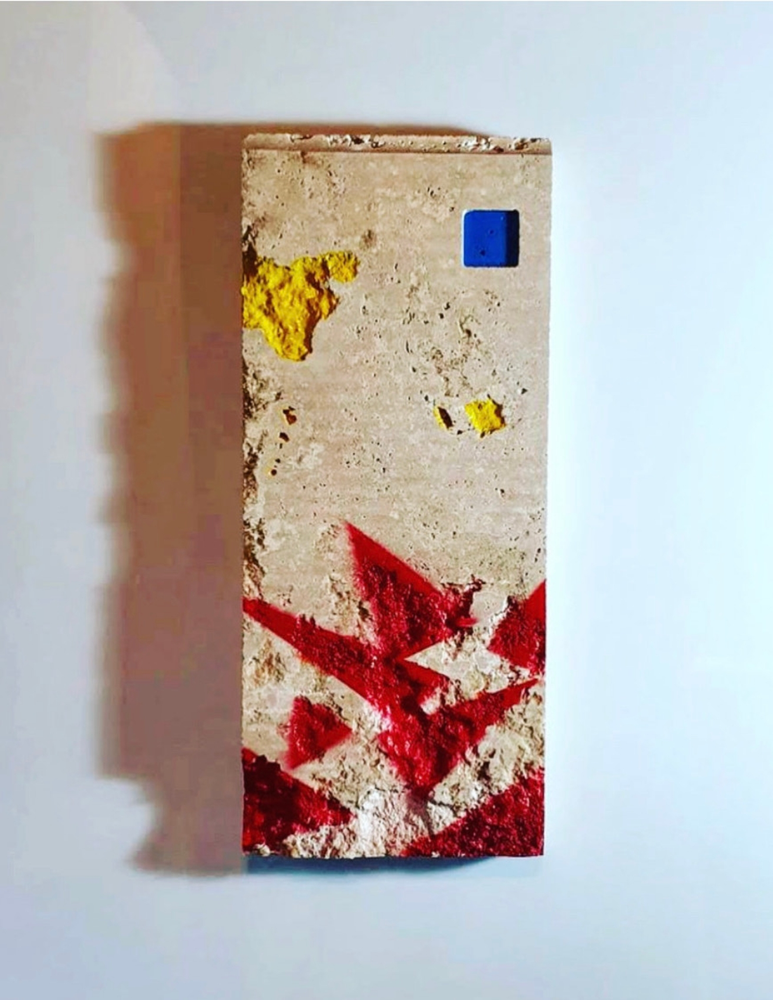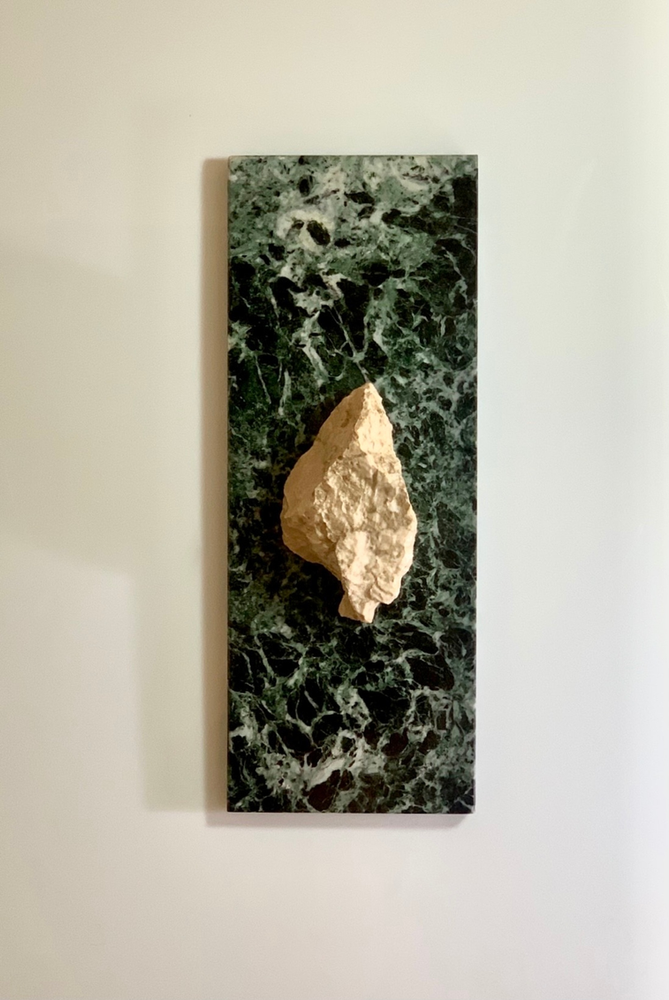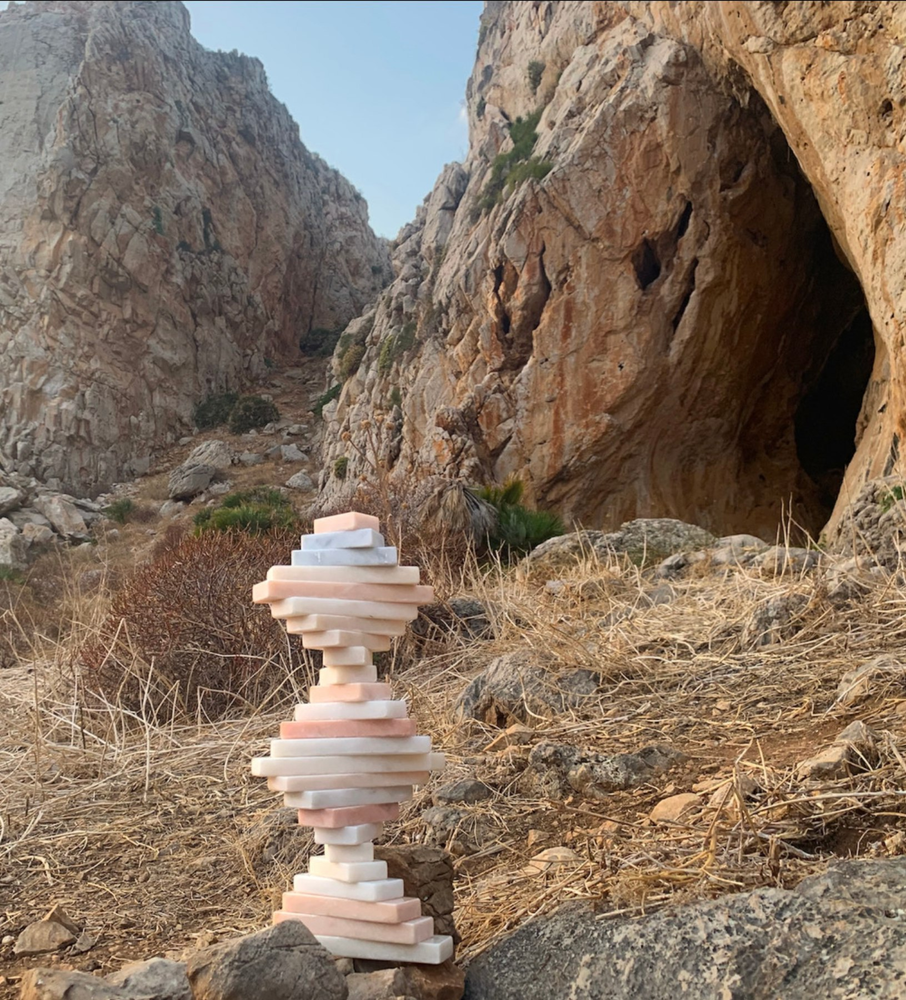
Luca Vitale
Appartenente a una famiglia di artigiani marmisti, Luca Vitale conosce perfettamente la capacità di adattamento delle pietre dure ai vari utilizzi che normalmente se ne fanno, tanto quanto apprende le tecniche per lavorarle, sviluppando il desiderio di recuperare l’approccio artistico che il marmo ha avuto nel passato pur riadattandolo alla contemporaneità, alle forme stilizzate e geometriche attraverso le quali mettere in luce le infinite sfaccettature che il marmo, il granito, il travertino, mostrano in modo naturale e che si armonizzano ai concetti essenziali del vivere attuale. La svolta verso il suo linguaggio artistico e la spinta a esaltare la naturale bellezza della pietra naturale avvengono nel momento in cui sul mercato del marmo vengono introdotte le imitazioni sintetiche che hanno provocato in lui una reazione, una ribellione a seguito della quale è iniziato un importante percorso creativo. Lo stile che Vitale predilige è Astratto ma soprattutto Concettuale perché al centro delle sue sculture pone l’armonia, spesso dimenticata, tra uomo e natura dove l’arte diviene un mezzo di interazione, un elemento di congiunzione tra la silenziosa presenza del mondo circostante e l’emotività di un’esistenza contemporanea che spesso viene tralasciata, dimenticata dietro il pragmatismo e la contingenza in cui il distacco sembra essere una corazza necessaria. Vitale mostra invece come la durezza della pietra possa diventare malleabile davanti all’impulso artistico, quel mondo emozionale in grado di scalfire anche l’armatura più dura ed entrare in connessione con le profondità non solo dell’animo umano bensì anche di quelle energie sottili che appartengono alla natura, che circondano l’uomo restando spesso inascoltate eppure costantemente presenti. La passione dell’artista romano nei confronti della pietra è di tipo totale, perché è affascinato dalla sua capacità di aver attraversato i secoli e di aver sfidato passaggi e trasformazioni mostrando una resilienza incredibile, così come dalla malleabilità grazie alla quale ha costituito un importante riferimento per tutto il corso della scultura, dalla Classica alla Moderna per giungere alla Contemporanea, lasciando testimonianza del cambiare dei tempi, storici e artistici, e sottolineando la versatilità e l’adattabilità ai differenti linguaggi espressivi per cui è stata utilizzata. Le opere di Vitale vanno in fondo all’interiorità umana che si lega alla naturalezza delle venature del marmo sul quale in alcuni casi, come nella scultura Aca toro,

Aca Toro
interviene con colori primari per esporre in maniera più incisiva il concetto che desidera raccontare; in quest’opera il travertino con le sue porosità è la superficie perfetta per narrare il cielo e il sole iberici che assistono impotenti allo svolgersi di una pratica tradizionale ma crudele, quella della corrida, metafora della scelta troppo spesso effettuata dall’uomo di combattersi piuttosto che lasciarsi andare all’armonia che invece sarebbe più risolutiva e rasserenante. In Ferite

Ferite
invece Luca Vitale lascia che siano le naturali venature del marmo rosa del Portogallo a delineare ed enfatizzare quelle cicatrici a cui fa riferimento il titolo, i segni che ogni percorso di vita porta con sé e che possono solo essere affrontate e riposte nel bagaglio dell’esperienza in virtù della quale tutto è cambiato. La maggiore espressività e il massimo impatto vengono raggiunti però quando inserisce le sue sculture nei contesti naturali, proprio per sottolineare quella necessaria connessione tra uomo, natura e arte, che non può essere lasciata indietro piuttosto dovrebbe divenire un’abitudine imprescindibile attraverso cui rigenerarsi e abbandonarsi alle emozioni troppo spesso nascoste; due tra le più importanti installazioni sono Uomo millenario,

Uomo millenario
visibile presso il sito archeologico di Selinute e Fiore presso la Grotta dei Cavalli, entrambi in provincia di Trapani. Approfondiamo ora le tematiche artistiche direttamente con Luca Vitale.
Lei ha alle spalle una lunga tradizione familiare nella lavorazione del marmo, cosa ha significato crescere in un ambiente artigiano? Quanto è stata importante l’eredità delle conoscenze dei suoi genitori per indurla ad amare la pietra al punto di sentire il bisogno di elevarla a forma d’arte?
Crescere in un ambiente artigiano, qualsiasi esso sia, ti permette di acquisire una certa professionalità basata su competenze umane che le macchine non possono rimpiazzare: ingegno, manualità e creatività. Ma la scelta di comunicare qualcosa facendo arte è sempre soggettiva. Si dice che artisti si nasce e artigiani si diventa… I miei genitori mi hanno trasmesso la passione, elemento che fa incredibilmente la differenza nello svolgimento di un lavoro, e mi hanno sempre esortato a viaggiare. Se da bambino non avessi visitato il Parco Guell di Antoni Gaudi, probabilmente oggi non farei arte. È come se tutti quei colori avessero acceso qualcosa in me.
Il suo è un approccio Concettuale, Astratto ma di forte impatto espressivo, a cosa è dovuta la scelta di non avvicinarsi alla figurazione che forse avrebbe facilitato la lettura del messaggio da parte del pubblico?
Il figurativo mi è sempre interessato poco, forse perché esistono macchinari in grado di realizzare una statua alta due metri in un giorno; a me interessano molto di più i colori naturali, la forza espressiva di qualcosa che l’uomo può solo riprodurre. Il fascino delle coste di granito in Bretagna, le mille sfumature di rosa delle cave di Estremoz, le venature che tagliano le Alpi Apuane, i fori irregolari del travertino. È questo il linguaggio attraverso cui desidero comunicare.

Mutazioni
La sua lettura del vivere contemporaneo è meditativa, orientata a un’introspezione profonda di sé e del mondo osservato; quanto è importante lasciar emergere le emozioni attraverso il contatto e la vicinanza con l’arte? È stato forse il suo un percorso compiuto in prima persona e solo poi fuoriuscito sotto forma di esortazione, di invito all’osservatore a compierlo come risanamento interiore e riconciliazione con se stesso?
L’arte esiste da sempre. Basta fare una visita nelle grotte di Altamira per ammirare dipinti di migliaia di anni fa. Oggi la società gira a una velocità massima ed è difficile osservare il mondo di oggi, di ieri e di domani. Con la mia arte cerco di far riflettere, anche solo per un minuto, su alcuni temi fondamentali riguardanti l’uomo e la natura perfetta che ci circonda.

Fiore
Quali sono i grandi scultori del passato più o meno recente a cui si è ispirato, o che ammira particolarmente?
Richard Long è l’artista che sento più vicino in assoluto, ma anche tutto il movimento artistico della Land Art mi affascina.
Ci racconta i suoi prossimi progetti? Sarà possibile ammirare altre delle sue installazioni di dialogo tra arte e natura?
Sicuramente proseguirò con il tema delle installazioni in ambienti naturali, che è la forma espressiva più affine alla mia indole; nelle prossime ho intenzione di continuare ad approfondire il rapporto che c’è tra fiori e matematica in cui utilizzerò la tecnica dello stone balancing che permette di ritrovare l’equilibrio interiore in sinergia totale con la natura.
LUCA VITALE-CONTATTI
Email: lucavitalesculptor@gmail.com
Sito web: https://www.gigarte.com/lucavitale/home
Instagram: https://www.instagram.com/lucavitale_sculptor/
Marta Lock’s interviews:
Luca Vitale, the lyrically plastic voice of stone
Belonging to a family of marble craftsmen, Luca Vitale is perfectly aware of the ability of hard stones to adapt to the various uses that are normally made of them, as well as learning the techniques for working them, developing a desire to recover the artistic approach that marble had in the past while readapting it to the contemporary world, to stylised and geometric forms through which to highlight the infinite facets that marble, granite and travertine show in a natural way and that harmonise with the essential concepts of modern living. The turning point in his artistic language and the urge to exalt the natural beauty of natural stone came at a time when synthetic imitations were introduced onto the marble market, which provoked a reaction in him, a rebellion that led to the start of an important creative process. Vitale’s preferred style is Abstract, but above all Conceptual, because at the centre of his sculptures is the often forgotten harmony between man and nature, where art becomes a means of interaction, an element of conjunction between the silent presence of the surrounding world and the emotionality of a contemporary existence that is often overlooked, forgotten behind pragmatism and contingency where detachment seems to be a necessary armour. Instead, Vitale shows how the hardness of stone can become malleable in the face of artistic impulse, that emotional world able to scratch even the hardest reinforcement and connect with the depths not only of the human soul but also of those subtle energies that belong to nature, which surround man, often remaining unheard yet constantly present. The Roman artist’s passion for stone is total, because he is fascinated by its ability to have travelled through the centuries and to have challenged transitions and transformations, showing incredible resilience, as well as by the malleability thanks to which it has been an important reference point for the whole course of sculpture, from Classical to Modern to Contemporary, bearing witness to the changing times, both historical and artistic, and underlining its versatility and adaptability to the different expressive languages for which it has been used. Vitale’s artworks go deep into the human interiority which is linked to the naturalness of the veining of the marble on which in some cases, as in the sculpture Aca toro, he intervenes with primary colours to expose more incisively the concept he wishes to tell; in this work, travertine with its porosity is the perfect surface for narrating the Iberian sky and sun, which helplessly watch the cruel but traditional practice of bullfighting unfold, a metaphor for the choice all too often made by man to fight each other rather than let himself go to the harmony that would be more decisive and reassuring. In Ferite (Wounds), Luca Vitale lets the natural veins of pink Portuguese marble outline and emphasise the scars referred to in the title, the signs that every life journey brings with it and that can only be faced and placed in the baggage of the experience by virtue of which everything has changed. However, the greatest expressiveness and impact are achieved when he places his sculptures in natural contexts, precisely to underline the necessary connection between man, nature and art, which cannot be left behind but should rather become an essential habit through which to regenerate and abandon oneself to emotions that are all too often hidden; two of his most important installations are Uomo millenario, which can be seen at the archaeological site of Selinute, and Fiore at Grotta dei Cavalli, both in the province of Trapani. Let’s delve into the artistic issues directly with Luca Vitale.
You have a long family tradition of working with marble, what did it mean to grow up in an artisan environment? How important was the inheritance of your parents’ knowledge for you to love stone to the point of feeling the need to elevate it to an art form?
Growing up in an artisan environment, whatever it may be, allows you to acquire a certain professionalism based on human skills that machines cannot replace: resourcefulness, manual skills and creativity. But the choice of communicating something by making art is always subjective. It is said that one is born an artist and one becomes an artisan… My parents passed on their passion, which makes an incredible difference when doing a job, and they always encouraged me to travel. If I hadn’t visited Antoni Gaudi’s Park Guell as a child, I probably wouldn’t be making art today. It is as if all those colours had ignited something in me.
Your approach is conceptual, abstract but with a strong expressive impact. Why did you choose not to go into figurative art, which would have made it easier for the public to read your message?
I have always been not very interested in figurative art, perhaps because there are machines that can make a two-metre high statue in a day; I am much more interested in natural colours, in the expressive power of something that man can only reproduce. The fascination of the granite coasts in Brittany, the thousands of shades of pink in the quarries of Estremoz, the veins that cut the Apuan Alps, the irregular holes in travertine. This is the language through which I wish to communicate.
Your reading of contemporary life is meditative, oriented towards profound introspection of yourself and the world you observe; how important is it to let your emotions emerge through contact and closeness with art? Was this a path you followed in person and only later emerged as an exhortation, an invitation to the observer to follow it as an inner healing and reconciliation with himself?
Art has always existed. One need only visit the caves of Altamira to admire paintings from thousands of years ago. Today, society spins at top speed and it is difficult to observe the world of today, yesterday and tomorrow. With my art, I try to make people think, even for a minute, about some fundamental themes concerning man and the perfect nature that surrounds us.
Who are the great sculptors of the more or less recent past that you have been inspired by, or that you particularly admire?
Richard Long is the artist I feel closest to, but I am also fascinated by the whole Land Art movement.
Can you tell us about your next projects? Will it be possible to admire more of your installations of dialogue between art and nature?
I will certainly continue with the theme of installations in natural environments, which is the form of expression most akin to my nature; in my next projects, I intend to continue to explore the relationship between flowers and mathematics, in which I will use the technique of stone balancing, which allows you to rediscover your inner balance in total synergy with nature.
